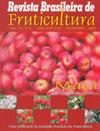Adjustment of mixed nonlinear models on Blackberry fruit growth
IF 0.9
4区 农林科学
Q4 HORTICULTURE
引用次数: 0
Abstract
Abstract Blackberry fruits belong to the genus Rubus, are fruits more cultivated in temperate climate in the summer, with low luminosity and low temperature in the winter. These fruits have as characteristic the quickperishingafter harvest and regression models, more specifically, nonlinear models, single or double sigmoid growth curve, are more recommended to model the growth of living beings. Several authors have used these models, considering only the average data of individuals under study; however, they do not consider the variability between them. One way to better capture the variability between individuals is by using mixed-effects nonlinear models that, by definition, combine the fixed and random part in the same model. Data used in this work were diameter and length of ‘Choctaw’ blackberry fruits, . The random effects of models were tested on parameters, with some steps, in order to reach the most appropriate model. For fixed-effects models, the least squares method was used, and for mixed models, the restricted likelihood was used. To reach the model that best fits data, the fit quality criteria (R2, AIC c and TRV) were used. For fruit diameter, the simple sigmoid nonlinear model was the logistic with random effect in ß1 and ß2, and for fruit length, the model was the Logistic + Logistic, with random effect in ß1 and ß4.黑莓果实生长混合非线性模型的调整
黑莓果实属于黑莓属,夏季多在温带气候中栽培,冬季光照低,温度低。这些水果具有采收后易腐烂的特点,而回归模型,更具体地说,是单双s型生长曲线的非线性模型,更适合用来模拟生物的生长。一些作者使用了这些模型,只考虑被研究个体的平均数据;然而,他们没有考虑到它们之间的可变性。一种更好地捕捉个体间可变性的方法是使用混合效应非线性模型,根据定义,它将固定部分和随机部分结合在同一个模型中。在这项工作中使用的数据是黑莓果实的直径和长度。为了得到最合适的模型,对模型的随机效应进行了参数检验,并进行了一定的步骤。对于固定效应模型,使用最小二乘法,对于混合模型,使用限制似然。采用拟合质量标准(R2、AIC c和TRV)来达到最适合数据的模型。对于果实直径,简单的s形非线性模型为ß1和ß2中具有随机效应的logistic,对于果实长度,模型为logistic + logistic,在ß1和ß4中具有随机效应。
本文章由计算机程序翻译,如有差异,请以英文原文为准。
求助全文
约1分钟内获得全文
求助全文
来源期刊
CiteScore
1.50
自引率
20.00%
发文量
34
审稿时长
4-8 weeks
期刊介绍:
The Revista Brasileira de Fruticultura (RBF) publishes technical articles and scientific communications in the area of fruit crops, referring to results of original searches and unpublished papers in Portuguese, Spanish or English, and 1 or 2 reviews per edition, of invited authors.

 求助内容:
求助内容: 应助结果提醒方式:
应助结果提醒方式:


